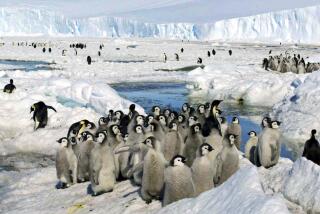Satellites Give Peek at Penguin ‘Oases’
- Share via
Two satellites have helped scientists learn about the hard-to-find Antarctic Ocean “oases” where penguins feast and thrive, researchers said Tuesday.
These oases are warm patches in the normally ice-covered ocean along Antarctica’s coast, enabling massive stretches of open water to support the microscopic plants that are the base of a food chain that ultimately feeds penguins, whales, seals and other animals.
Some of these stretches of open water, known as polynyas, are as big as mini-oceans themselves -- at least one is the size of California -- but because they are surrounded by ice, they are impossible to see by ship.
“We used different kinds of satellites to look at the sea ice so we could see how much open water there was, and we used the ocean-color sensor,” said Gert van Dijken of Stanford University.
Researchers determined that if the water was green, it was full of phytoplankton, the tiny plants that nourish minuscule shrimp-like creatures called krill.
Krill are on the menu for many larger Antarctic creatures, notably the Adelie penguins whose population thrives on some of these polynyas, Van Dijken said.
Research by Van Dijken and his colleagues found a strong association between the well-being of the Adelie penguins and the amount of phytoplankton in the polynyas.
The researchers used data from two satellites: a NASA sea-viewing and a National Oceanic and Atmospheric Administration advanced high-resolution radiometer. The research appeared in a recent edition of the Journal of Geophysical Research.




